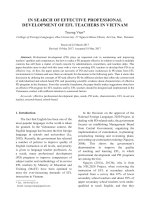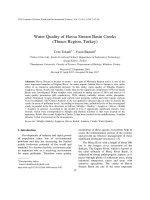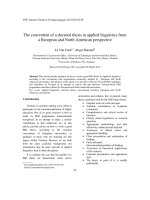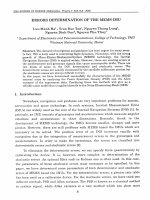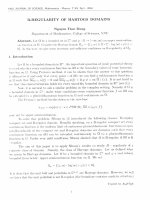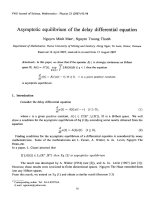DSpace at VNU: Direct production of highly conductive graphene with a low oxygen content by a microwave-assisted solvothermal method
Bạn đang xem bản rút gọn của tài liệu. Xem và tải ngay bản đầy đủ của tài liệu tại đây (2.24 MB, 39 trang )
Accepted Manuscript
Direct production of highly conductive graphene with a low oxygen content by
a microwave-assisted solvothermal method
Tran Van Khai, Dong Sub Kwak, Yong Jung Kwon, Hong Yeon Cho, Tran Ngoc
Huan, Hoeil Chung, Heon Ham, Chongmu Lee, Nguyen Van Dan, Ngo Trinh
Tung, Hyoun Woo Kim
PII:
DOI:
Reference:
S1385-8947(13)01043-7
/>CEJ 11103
To appear in:
Chemical Engineering Journal
Received Date:
Revised Date:
Accepted Date:
29 March 2013
25 July 2013
31 July 2013
Please cite this article as: T.V. Khai, D.S. Kwak, Y.J. Kwon, H.Y. Cho, T.N. Huan, H. Chung, H. Ham, C. Lee,
N.V. Dan, N.T. Tung, H.W. Kim, Direct production of highly conductive graphene with a low oxygen content by
a microwave-assisted solvothermal method, Chemical Engineering Journal (2013), doi: />j.cej.2013.07.123
This is a PDF file of an unedited manuscript that has been accepted for publication. As a service to our customers
we are providing this early version of the manuscript. The manuscript will undergo copyediting, typesetting, and
review of the resulting proof before it is published in its final form. Please note that during the production process
errors may be discovered which could affect the content, and all legal disclaimers that apply to the journal pertain.
Direct production of highly conductive graphene with a low
oxygen content by a microwave-assisted solvothermal method
Tran Van Khaia,e, Dong Sub Kwaka, Yong Jung Kwona, Hong Yeon Choa, Tran Ngoc
Huanb, Hoeil Chungb, Heon Hamc, Chongmu Leed, Nguyen Van Dane, Ngo Trinh Tungf,
Hyoun Woo Kima,*
a
Division of Materials Science and Engineering, Hanyang University, 17 Haengdang-dong, Seongdong-
Gu, Seoul 133-791, Republic of Korea
b
Department of Chemistry, Hanyang University, 17 Haengdang-dong, Seongdong-Gu, Seoul 133-791,
Republic of Korea
c
H&H Co. LTD, Chungju National University, 50 Daehak-ro, Chungju-si, Chungbuk, 330-702, Korea
d
School of Materials Science and Engineering, Inha University, Incheon 402-751, Republic of Korea
e
Faculty of Materials Technology, Ho Chi Minh City University of Technology,268 Ly Thuong Kiet
street, Ward 14, District 10, HoChiMinh City, Viet Nam
f
Institute of Chemistry, Vietnam Academy of Science and Technology (VAST), 18 Hoang Quoc Viet,
Caugiay, Hanoi, Viet Nam
*
Author to whom correspondence should be addressed. Tel.: +82-10-8428 0883.
E-mail address :
Keywords: Graphene; Solvothermal; Microwave
AB STRACT
Few-layer graphene (FLG) with a low oxygen content has been synthesized by a twostep process using expanded graphite (EG) as a starting material. EG was subjected to
solvothermal treatment, followed by microwave radiation. The FLG had an average
thickness in the range of 1.8-2 nm with a lateral size of 3-10 µm. Both Raman
spectroscopy and high resolution TEM measurements showed that the sizes of sp2
carbon domains in graphene oxide (GO) and FLG were estimated to be about 2-5 nm
1
and 10-16 nm, respectively. X-ray photoelectron spectroscopy and Fourier transform
infrared spectroscopy spectra revealed that the FLG consisted of several peaks similar to
those of EG, which were not observed in GO, indicating the effectiveness of the
solvothermal reduction method in lowering the oxygen level. The electrical conductivity
of the as-synthesized FLG is measured to be 165 S/m, which is much higher than that of
the GO (1.2x10-4 S/m), possibly due to the larger sp2 carbon domain size, lower oxygen
content, and fewer structural defects. In contrast to the Hummer method, the method is
simple, inexpensive, and does not generate toxic gas. This simple method could provide
the synthesis of high quality FLG on a large scale.
1. Introduction
Graphene is a single layer of sp2-hybridized carbon atoms arranged in a twodimensional hexagonal lattice. Due to their outstanding physical and chemical
properties, graphene and its derivatives have attracted tremendous attention for both
fundamental science and possible technological applications [1-6]. Graphene-based
sheets have been shown to be very promising for high-performance nanoelectronics,
transparent conductors, polymer composites, and microscopy support, etc. Currently,
various methods have been developed for production of graphene, including chemical
vapor deposition (CVD) [7], micromechanical exfoliation of graphite [8], epitaxial
growth on electrically insulating surfaces such as SiC [9], physical method [10] and
chemical processing [11,12]. Among them, the chemical approach is the most suitable
method for economically producing graphene sheets on a large scale.
Currently, the Hummers’ method is the most widely used technique for preparing
GO [13], which involves oxidation of graphite in the presence of strong acids and
2
oxidants. When oxidized, GO still possess a layered structure, being composed of
unoxidized aromatic regions and aliphatic regions, which contain many oxygen
functional groups [14,15]. The -conjugated system in graphene is disrupted by these
oxygen-containing functional groups, producing separated nanocrystalline graphene.
Since the as-prepared GO is an electrical insulator, various reduction methods have been
developed to efficiently recover its electrical property. However, reduced graphene
oxide (RGO) still exhibits much lower conductivity than pristine graphene, mainly due
to the presence of irreversible defects, disorder and residual functional groups.
Moreover, the reduction of GO involves strong reductive agents, such as hydrazine or
dimethyl hydrazine, which are highly toxic and dangerously unstable. Therefore, direct
thermal annealing at elevated temperatures, or CVD, is required to repair the defects
and further remove the residual functional groups in RGO to improve its electrical
properties, while eliminating the use of potentially hazardous reducing agents. However,
these treatments increase the cost and complexity of the CVD process and they are
unfavorable for low-temperature applications.
In order to avoid applying Hummers’ method, Liang et al. [16] suggested a vacuum
filtration method where reduction-fee thermally conductive surface functionalized
multilayer graphene sheets are aligned in water to create paper-like graphene with low
defect level and high conductivity. Recently, solvothermal techniques have been
employed to produce graphene [17]. Due to their unique features, such as very high selfgenerated pressure inside the sealed reaction vessel and containment of volatile
products, solvothermal techniques are well suited for the preparation of metastable
phases. Nethravathi and Rajamathi [18] and Dubin et al. [19] also reported the
solvothermal reduction of exfoliated GO in organic solvents. On the other hand, Liang
et al. [20] suggested that microwave could reduce defects on graphene sheet and
3
concentration of function groups. However, this method presents the same
disadvantages as all synthetic approaches where GO is used as starting material: the sp3
defects cannot efficiently convert to sp2 and the remaining oxygen groups [18,21].
Therefore, it is necessary to develop an effective method to directly produce graphene
sheets, which have less defects and low oxygen content, resulting in much better
conductivity. In this regard, we propose a simple method to produce graphene sheets by
means of the microwave irradiated expansion of graphite intercalation compounds,
which have been prepared through a solvothermal process. One of the advantages of this
synthetic method is its simplicity without toxic chemical agents and harsh oxidation of
graphite. Microwave irradiation facilitates mass production in a short time with little
energy cost. Herein, we will show a detailed study of the structure and properties of the
obtained FLG, in comparison to those of GO prepared by a modified Hummers’ method.
2. Experimental
We used commercial EG as the starting material. This is transformed to a sheet
with 2 to 5 atomic layers, though microwave irradiated expansion following a
solvothermal process. This method is simple, inexpensive, produces usable results, and
especially, does not generate toxic gas. Briefly, a potassium organic solution was first
prepared by adding a stoichiometric amount of potassium hydroxide, 5 gram to 50 mL
of tetrahydrofuran (THF) organic solvent (i.e., the mass ratio of KOH to THF ≈ 0.1),
and stirred for 24 h at room temperature. Then, 0.5 gram EG was added to this solution,
and the resulting mixture was transferred to a Teflon-lined autoclave (25 mL) and
maintained at 250oC for 72 h, during which time the mixture was stirred with a Teflon
magnetic stirrer. At the same time, the dissolved potassium ion in the solvent is
4
intercalated into the interlayer space of the graphite, forming a black suspension. Next,
the reaction products were irradiated by rapid microwave heating for 60 to 120 seconds
using a commercial microwave oven (Panasonic, model: NE-1054F 1000-Watt- 2,450
MHz, 0.8 cubic feet cavity, power source: 120V, 60Hz). Then, we can obtain the
exfoliated graphene sheets from the irradiated intermediate of alkali metal intercalated
EG. The obtained exfoliated graphene nanosheets were then redispersered in HCl (3%)
solution with mild sonication for 3 h, and repeatedly washed with distilled water until
the pH = 7. To obtain uniform graphene sheets, a low-speed centrifugation at 2000 rpm
(5 min) was first used to remove thick sheets. Then the supernatant was further
centrifuged at 6000 rpm for 30 min to remove small graphene pieces and water-soluble
byproduct. The final sediment was dried and stored in a vacuum oven at 60oC until use.
For comparison, we prepared GO from EG by a modified Hummer’s method. In a
typical reaction, 5 g of EG, 60 mL of H3PO4, and 240 mL of H2SO4 were stirred together
with a Teflon-coated magnetic stirrer in an ice bath. Next, 60 g of KMnO4 was slowly
added while the temperature was maintained at 0oC. Once mixed, the solution was
transferred to a 35 ± 5 oC water bath and stirred for 3 h, forming a thick paste. Next,
distilled water (450 mL) was slowly dropped into the resulting paste to dilute the
mixture, and then the solution was stirred for 1 h while the temperature was raised to 90
± 5 oC. Finally, 800 mL of distilled water was added, followed by the slow addition of
60 mL H2O2 (30%), turning the color of the solution from dark brown to yellow. During
this final step, H2O2 (30%) reduced the residual permanganate and manganese dioxide
to colorless soluble manganese sulfate. The GO deposit was collected from the GO
suspension by high speed centrifugation, at 15000 rpm for 30 min. The obtained GO
was then washed with 1000 mL of HCl (5%), and repeatedly washed with distilled
water until the pH = 7. To obtain uniform GO, a low-speed centrifugation at 3000 rpm
5
was first used to remove thick multilayer sheets until all the visible particles were
removed (3-5 min). Then the supernatant was further centrifuged at 10000 rpm for 30
min to remove small GO pieces and water-soluble byproduct. Next, the obtained GO
was dried and stored in a vacuum oven at 90oC until use. The exfoliated GO nanosheets
were chemically reduced to graphene in the presence of hydrazine. Typical, 500 ml of
above exfoliated GO was stirred for 30 min, and 50 ml of hydrazine monohydrate was
added. The mixtures were heated at 150 ± 5 oC using an oil bath for 48 h; a black solid
precipitated (called RGO) from the reaction mixtures. Products were collected by
centrifugation at 12000 rpm for 45 min and washed with DI water and methanol until
the pH = 7.
The synthesized products were characterized by using a field-emission scanning
electron microscope (FE-SEM, JSM-6700, JEOL Ltd., Tokyo, Japan) operated at an
accelerating voltage of 12 kV. Transmission electron microscope (TEM) images were
obtained on a JEOL JEM-2010 TEM (JEOL Ltd., Tokyo, Japan) with an accelerating
voltage of 200 kV. Atomic force microscope (AFM) images were obtained on an AFM
XE-100 (Park system) equipment. Optical microscope (OM) examination was carried
on a Zeiss AX10 microscope. X-ray diffraction (XRD) characterization was obtained
using a D/MAX Rint 2000 diffractometer model (Rigaku, Tokyo, Japan) with CuKα
radiation (λ = 1.54178 Å, 40 kv, 200 mA). The Raman spectra were taken using a Jasco
Laser Raman Spectrophotometer NRS-3000 Series, with excitation laser wavelength
and power density of 532 nm and 2.9 mW·cm-2, respectively. X-ray photoelectron
spectroscopy (XPS, VG Multilab ESCA 2000 system, UK) analysis using a
monochromatized Al Kα x-ray source (hν = 1486.6 eV) was performed to analyze the
elemental compositions and the assignments of the carbon peaks of the samples at the
Korean Basic Science Institute. The Fourier transform infrared (FTIR) spectra (500-
6
4000 cm-1) were obtained using a Nicolet IR100 FTIR spectrometer. The Ultravioletvisible (UV-vis) absorption spectra were performed on a Shimazu UV-3600 Ultravioletvisible-near infrared (UV-vis-NIR) spectrophotometer at room temperature. The
current-voltage (I-V) characteristics of the samples were measured by the four probe
method within an applied voltage ranging from -1.0 to 1.0 V using a source meter
(Keithley Model 2400, OH, USA).
3. Results and discussion
Fig. 1 shows typical FE-SEM images of the as-made GO sheets. From Fig. 1a, the
thin wrinkled accordion- or worm-like structure morphology of the GO sheets can be
observed. This material consists of randomly aggregated, thin and wrinkled sheets,
being loosely associated with each other. Most of the GO has been efficiently exfoliated
to single or few-layer GO sheets in the present work. Fig. 1b shows a high-resolution
FE-SEM image of the GO. It is clearly seen that the GO sheets predominantly consist of
single or double layer graphene, with some of them being overlapped. The edges of the
sheets are partially folded so that the total surface energy can be reduced. In comparison
to the GO, the FE-SEM images of the FLG in Figs. 2a and 2b reveal that the FLG
consist of randomly individual graphene sheets that are separated from each other. The
size of the sheets ranged from 3 to 10 µm. Fig. 2c shows the moderate-magnification
FE-SEM image of single layer graphene sheets. Fig. 2d displays a high magnification
FE-SEM image of a single layer graphene sheet. It clearly shows the wrinkles on the
surface and folding at the edges of graphene sheet. Fig. 3 show the typical OM images
of FLG sheets with the size in range of 5-7 µm, which are in quite agreement with the
SEM results.
Fig. 4 shows typical TEM images of the as-synthesized GO (a and b) and FLG (c
7
and d). As shown in Fig. 4a, the transparent GO sheets with wrinkled feature are easily
observed. The as-prepared GO sheets are single-layer- or double-layer-thick with lateral
dimensions from several micrometers to several ten micrometers. The electron
diffraction pattern in Fig. 4a indicates that the formed GO corresponds to the ordered
stage structure rather than the amorphous structure. The high-resolution TEM image of
a single layer GO sheet is shown in Fig. 4b. It clearly shows that the GO sheet is folded
at the edges with numerous wrinkles on its surface. Fig. 4c shows some bi-layer
graphene sheets with many ripples and wrinkles on their surface, and most of them are
folded at their edges [22]. The electron diffraction patterns in Fig. 4c of FLG are
comprised of a single set of hexagonal patterns similar to those commonly observed in
single-layer graphene and GO [23,24], indicating that the obtained FLG are wellcrystallized. Fig. 4d reveals the TEM image of a single-layer graphene sheet with lateral
dimensions of 2-5 µm, and how the edge tends to scroll.
The morphology and thickness of GO and FLG were also measured by AFM and
the results are shown in Fig. 5. The AFM image of GO shows nanosheets with wrinkles
on their surface. The thickness of the GO obtained from the height profile analysis of
AFM image is about 1.2 nm, which suggests that the single or double-layer GO
nanosheets are formed because the thickness of a one layer GO nanosheet is about 0.81.6 nm [25-27]. Such thickness is significantly larger than that of single-layer pristine
graphene ( 0.34 nm) and is commonly attributed to the presence of oxygen-containing
functional groups attached on both sides of the graphene sheet and to the atomic scale
roughness arising from structural defects (sp3 bonding) generated on the originally
atomically flat graphene sheet [28]. Thus, individual GO sheets are expected to be
thicker ( 0.8-1.6 nm) than individual pristine graphene sheets ( 0.34 nm).
In the case of FLG, a two dimensional AFM image is shown in Fig. 5b. It is found
8
that the thickness of sheets obtained is about 1.8-2 nm, which is larger than the
thickness of double-layer graphene (1.22 nm) [29]. Considering the oxygen-containing
functional groups that are on both sides of the graphene, the products are double-layer
graphene. The three dimensional AFM image reveals the FLG with uniform thickness
and a homogenous smooth surface, as seen in Fig. 5c. It is clear that the FLG
synthesized by our method are nanosized in the vertical direction and microsized in the
horizontal direction.
Fig. 6a shows the XRD patterns of EG, GO, RGO and FLG. The EG shows the
very strong (002) peak at 2θ = 26.10o, corresponding to interlayer distance (d-spacing)
of about 3.40Å (estimated from the Bragg equation). However, after the oxidation of
EG to GO, the (002) peak shifted to a lower angle of around 2θ = 11.15o and the dspacing of GO increased to 7.90 Å. Such d-spacing is significantly larger than that of
single-layer graphene (~3.35Å), indicating that GO contains large numbers of oxygencontaining functional groups on both sides of the graphene sheets. In addition, some
small bumps near 22o and 26o indicate that the GO has not been completely oxidized.
For RGO sample, the peak disappeared in a region of low angle and another broad peak
at 21.31o corresponding to d-spacing of 3.50 Å appeared. This indicated that a large
number of functional groups on the surface of GO was removed during chemical
reduction process. In contrast, in the diffraction pattern of FLG shows a strong and
sharp (002) peak at around 2θ = 26.23o corresponding to d-spacing of 3.39 Å, which is
very close to that of conventional graphene (~3.35Å). That implies that there are only a
few oxygen functional groups in the interlayer of the FLG, demonstrating the
effectiveness of the solvothermal method.
FTIR analysis of the as-made samples was carried out to provide compositional
and structural information of the samples. Fig. 6b shows FTIR spectra of EG, GO, RGO
9
and FLG. In the spectrum of EG, the peak at 1699 cm-1 can be attributed to the stretching
vibration of C=O [30]. The strong peak at 1531 cm-1 can be ascribed to the vibration of
aromatic C=C [31]. The spectrum also shows two peaks at 1218 and 1061 cm-1, being
originated from the C-O stretching vibrations of epoxy and alkoxy, respectively [30,32].
Finally, the peak at 1342 cm-1 can be due to the variations of tertiary C-OH groups [30].
This result suggests that a certain number of oxygen functional groups have been
introduced into the carbon frameworks of the EG material. It is certain that some degree
of intercalation occurs in EG, and these intercalation sites provide a path for K+ species.
After oxidation of EG to GO, new peaks appear at 3350 and 1374 cm-1, corresponding
to the O-H stretching vibration of adsorbed water molecules, and O-H deformation
vibration mode, respectively [30]. The peak at 1614 cm-1 is attributed to the O-H
bending vibration of absorbed water molecules and contributions from the vibration of
aromatic C=C [33]. The peak at 1153 cm-1 can be attributed to C-O stretching of the
ester group [34]. The spectrum of GO also shows a stretching vibration of C=O at 1723
cm-1, which is slightly shifted to higher wave-number, being compared with that of the
EG. Note that the peak at around 1531 cm-1 (C=C bonds) disappears, indicating that the
harsh oxidation led to the loss of the structural integrity of the graphite. In the FT-IR
spectrum of the RGO, the peaks at 1614, 1374 and 1218 cm-1 disappeared. The intensity
of peak at 1061, 1727 and broad peak at 3480 cm-1 was markedly reduced, indicating
the removal of the hydroxyl and carboxylic acid groups. It did not completely disappear
because of the mild reaction conditions. In addition, there are three new bands at 1551,
1408 and 1194 cm-1 appeared in the spectrum of RGO. The band at 1551 corresponds to
aromatic C=C bonds. The two bands at 1408 and 1194 can be attributed to sp3 C-N and
C-N stretching modes, respectively. Nevertheless, in the case of FLG, the peaks appear
to be very similar to that of EG, suggesting that their original pristine structure has been
10
retained in the final products. In addition, the peak intensity of oxygen functional
groups of FLG (even some of them disappear) is much lower than those of GO and EG,
suggesting the effectiveness of the solvothermal process in removing oxygen functional
groups residing on the surface of the EG.
Fig. 7a shows the UV-vis spectra of GO and FLG dispersed in distilled water. The
spectra of GO shows a high peak at 229 nm corresponding to the π → π* transition of
aromatic C=C bonds and a small shoulder at 299 nm, which can be attributed to the n →
π* transition of C=O bonds [35]. Only an intensity peak is observed at 269 nm for FLG,
and the shoulder peak near 299 nm disappears. A large redshift of 40 nm in the
absorption band of FLG compared with that of GO suggests that the π-conjugation
within the FLG is less disrupted than that of GO [36,37]. A similar result has been
observed in the previous study [38].
Raman spectroscopy is usually used to characterize carbon materials. Fig. 7b
shows the Raman spectra of EG, FLG, RGO and GO. The EG has a prominent G band at
1583 cm-1, which is assigned to the first-order scattering of the E2g mode, being related
to sp2 carbon domains. Also, it has a broad D band at 1356 cm-1, being caused by sp3hybridized carbon, structural defects, carbon amorphous or edge planes that can break
the symmetry and selection rule [39]. In the Raman spectrum of GO, the G band is
broadened and shifted to 1600 cm-1, while the D band at 1354 cm-1 becomes prominent,
indicating the destruction of the conjugated system in graphite due to harsh oxidation by
strong acids during preparation. After GO was reduced to RGO, the D band became
narrower and more prominent whilst the G band shifted from 1600 cm-1 to 1594 cm-1,
possibly due to increase of the number of sp2 carbon in the graphene sheets. In contrast,
in the Raman spectrum of FLG, the G band appears at 1583 cm-1, which is consistent
with the value in bulk EG, suggesting that the solvothermal process does not
11
significantly disrupt the sp2 carbon networks in the graphene sheets. It is worth noting
that the D band of FLG also appears at a frequency of 1356 cm-1 and its intensity is
higher than that of EG, but much lower than that of GO, indicating that the solvothermal
method does not create significant structural defects. Our result is in good agreement
with the previous study by Qian et al. [40]. The intensity ratio of D band to G band
(ID/IG) is usually used to measure the graphitization degree of carbon materials. The
ID/IG is estimated to be about 0.14, 0.23, 0.86 and 1.0 for EG, FLG, GO and RGO
respectively. The ID/IG ratio of GO, RGO is much higher than that of EG and FLG,
clearly indicating that GO and RGO has a higher distortion. The size of the sp2 carbon
domains (designated as La) can be calculated from the intensity ratio between D and G
band in the Raman spectra using Knight’s empirical formula [41].
La = 4.35(ID/IG)-1
(1)
The calculated size of sp2 domains is estimated to be ~ 31, 18, 5 and 4 nm for EG,
FLG, GO and RGO, respectively. After harsh oxidation process, the size of sp2 carbon
domain decreased from ~ 31 nm for EG to ~ 5 nm for GO, indicating destruction of the
sp2 atomic structure graphite. Furthermore, size of sp2 carbon domain of RGO
continuously decreased to ~ 4 nm, suggesting that the chemical reduction can easily
cause nucleation of sp2 domains in the sp3 matrix and the density of small sp2 nucleus
increased, decreasing the average size of sp2 domains. However, for FLG sheets, the
size of sp2 domain is about 18 nm, larger than that of GO and RGO, suggesting that the
effectiveness of the solvothermal method for remaining size of sp2 carbon domain in
graphene sheets. It is believed that the size of the sp2 domains plays a determining role
in the electronic properties of the carbon material [42].
XPS is a powerful tool for identifying elemental composition in bulk materials.
Furthermore, by analysis of binding energy (BE) values, we can detect the presence of
12
oxygenated groups. Fig. 8a shows the XPS survey spectra of EG, GO, RGO and FLG.
With only carbon, oxygen species being detected, the atomic percentage (at %) of each
element was calculated from the survey spectra and is summarized in Table 1. The
oxygen content was found to decrease in the order of GO > RGO > EG > FLG, clearly
indicating the effectiveness of the solvothermal method in lowering the oxygen and
defect levels in graphene sheets [21]. In contrast, the GO produced by the Hummers’
method can introduce many oxygen functional groups, such as COOH, -C=O, C-O-C,
and -OH, on to the surfaces of graphene sheets; consequently, the obtained GO is an
electrically insulating material. In the survey scan XPS spectra, the peaks at around
285.5 and 534.0 eV correspond to C1s and O1s core-level, respectively. Small peaks at
around (100-160 eV) and (399-403 eV) are due to silicon substrate and N1s core-level,
respectively. The N1s peak in the XPS spectrum of RGO can be ascribed to the
formation of C-N species during hydrazine reduction.
It is known that the electronic structure of the graphene is strongly influenced by
basal-plane or edge functionalization with oxygenated groups. In order to detect the
presence of oxygenated groups, high-resolution C1s XPS spectra were measured and
the results are shown in Fig. 8b, 8c, 8d and 8e. Note that the relative composition of
individual groups was estimated by the percentage of the certain group (the area of peak
divided by the total area of all peaks). For the EG, the C1s peak can be fitted to five
components located at 284.8, 285.6, 286.4, 287.2 and 288.5 eV. The main peak at 284.7
eV corresponds to BE of sp2 graphitic bonds (C=C), indicating that most of the carbon
atoms in the EG are arranged in a conjugated honeycomb lattice (77.0% area of C=C
bonds). The other four peaks located at 285.6, 286.4, 287.2 and 288.5 eV are attributed
to C-OH (hydroxyls), C-O-C (epoxy/ether), C=O (carbonyls), and COOH (acids)
groups, respectively. The C1s XPS spectrum of GO clearly indicates a considerable
13
degree of oxidation, with the content of oxygen element being increased to 25.2 at.%
and the composition of C=C bonds decreasing to 62.4%, which results from the harsh
oxidation and destruction of the sp2 atomic structure graphite [43]. There are six
different kinds of carbon atoms, located at 284.5, 285.6, 286.3, 287.5, 288.6, and 290.1
eV, correspondingly existing in different functional groups: C=C, C-OH, C-O-C, C=O,
COOH and O=CO-O (carbonates) groups, respectively. This indicates that the rich
oxygen groups are contained within the GO. For C1s XPS spectrum of RGO is found
that oxygen functional groups (such as C-OH, C-O-C, C=O and COOH groups) of GO
were considerably reduced after chemical reduction, while the composition of C=C
bonds increased from 62.4% for GO, to 74.1% for RGO. At the same time, some new
peaks ascribed to a C-N species, resulting from bond formation during hydrazine
reduction, appeared at 286.2 and 288.0 eV in the RGO spectrum. In contrast to GO and
RGO, FLG contains a very small amount of oxygen functional groups and some of them
have even disappeared, while the composition of C=C bonds was increased up to
88.2%, which is higher than that of GO and EG and RGO. This indicates the effective
restoration of the sp2 carbon networks by the solvothermal method.
To examine the electrical conductivity of the as-made GO, RGO and FLG, we
measured I-V characteristics by using four point probe with the Keithley 2400 Sourcemeter. In order to measure electrical conductivity, GO, RGO and FLG thin films of
about 300 nm thickness were deposited on glass substrates (2x2 cm2) from the GO,
RGO and FLG suspension using air-brush spraying technique [44]. Next, these films
were dried in a vacuum oven at 90oC for 24 h. Fig. 9 shows the I-V characteristic of
GO, RGO and FLG. It is found that all samples exhibit linear I-V relation with the
voltage in the range of -1.0 to +1.0 V. From the linear I-V curves, the conductivities of
1.2x10-4, 86 and 165 S/m were calculated for GO, RGO and FLG, respectively. The
14
result shows that the GO behaved like an insulating material [45], which can be
attributed to the high oxygen content in the form of functional groups contained by the
GO. It is well-known that the GO structure is predominantly amorphous due to
distortions from the high fraction of sp3-O. Moreover, due to the random distribution,
the sp2-hybridized benzene rings are separated by sp3-hybridized rings, thus leading to
the insulating GO [46].The I-V slope of GO is close to zero. However, the I-V slope of
RGO significantly increased after chemical reduction, indicating that the electrical
conductivity of RGO was enhanced. The enhanced electrical conductivity of RGO can
be due to chemical removal of oxygen functional groups during chemical reduction.
Interestingly, it was found found that the electrical conductivity of FLG is dramatically
improved, approximately 6 orders higher than that of GO and two times higher than that
of RGO, which is considerably higher than those prepared by other methods (50-100
S/m) [47,48], demonstrating the effectiveness of our method. The dramatic
enhancement of conductivity of FLG can be due to the lower oxygen content and
structural defect levels in graphene sheets, as shown by the Raman and XPS analyses.
It is believed that the concentration and size of sp2 carbon domains play very
important roles in controlling the electrical properties of the graphene sheets. In fact, it
is shown that the high conductivity of the graphene films resulted from the improved
sp2 carbon networks in the graphene sheets and the reduced interlayer distance between
the graphene sheets in the films [49]. Zhan et al. [50] reported that the dramatic
enhancement of conductivity of thermally reduced graphite oxide is due to the
restoration of sp2 hybridized carbon component and the removal of oxygenated
15
functional groups. Moreover, Mattevi et al. [51] showed that the conductivity of
thermally reduced GO increased with increasing the sp2 carbon fraction. These studies
suggest that the conductivity of graphene material depends on the quality of graphene
sheet, i.e., it depends mainly on the concentration and size of sp2 carbon domain in the
graphene sheets. In our study, according to the XPS results (Fig. 8), the C=C component
of GO, RGO and FLG sheet is estimated to be about: 62.4, 74.1 and 88.2 %,
respectively. At the same time, the size of sp2 carbon of GO, RGO and FLG sheet is
calculated to be 5, 4 and 18 nm (see Table 1, according to Raman data in fig. 7b),
respectively. Furthermore, high resolution TEM is also performed to analyze size of sp2
carbon domain of GO and FLG sheets and the results are shown in Fig.10. From Figs.
10a, 10b and 10c, it is seen that GO consist of ~ 2-5 nm sp2 carbon domains isolated
within sp3 carbon matrix. This is in accordance with the previous observation, revealing
the size of the sp2 domain of GO to be about 2.5-8 nm [51-53]. As shown in Fig. 10d, a
higher concentration and larger size of sp2 carbon domains (~10-16 nm) is observed in
the FLG, in good agreement with the XPS and Raman results. It is believed that the
higher concentration and larger size of the sp2 carbon domains in the FLG leads to an
increase in the number of conductive pathways, resulting in a dramatic increase in the
electrical conductivity [8,51]. In addition, it was also shown that the electrical
conductivity of graphene is directly related to the oxygen content [47]. In the present
16
case, the C/O ratio of FLG is calculated to be 14.4, which is much higher than that of
GO (2.2). By considering all these factors, we conclude that the higher electrical
conductivity of FLG is due to larger size of sp2 carbon domains and higher C/O ratio.
4. Conclusions
In conclusion, we reported a simple method of preparing few-layer graphene sheets
having low oxygen and structural defects levels, through a solvothermal process
followed by microwave-assisted expansion, using EG as starting material. This method
has the following advantages: (1) it can be applied to produce few-layer (2-3 layers)
graphene sheets with a lateral size up to several micrometers; (2) the obtained FLG has
higher C/O ratio and lower structural defect level (compared to those of chemical
reduction or thermal reduction of GO); (3) the method provides an alternative route for
producing large-scale high quality graphene sheets; (4) this method avoids the use of
toxic and harmful reducing agents, such as hydrazine, dimethyl hydrazine and
hydroquinone. The as-fabricated graphene sheets exhibited a high electrical
conductivity of ~ 165 S/m, which can open up a wide range of applications in
technology fields, such as ultra-sensitive gas sensor, transparent electrodes, solar cell,
field effect transistors and graphene-based composites.
17
ACKNOWLEDGEMENTS
This work was supported by the National Research Foundation of Korea(NRF) grant
funded by the Korea government(MEST) (No. 2012029262) and the National
Foundation for Science and Technology Development (NAFOSTED), Vietnam.
18
References
[1]
A.K. Geim, K.S. Novoselov, The rise of grapheme, Nature Mater. 6 (2007) 183191.
[2]
C. Lee, X. Wei, J.W. Kysar, J. Hone, Measurement of the elastic properties and
intrinsic strength of monolayer graphene, Science 321 (2008) 385-388.
[3]
A.A. Balandin, S. Ghosh, W.H. Bao, I. Calizo, D. Teweldebrhan, F. Miao, C.
Lau, Superior thermal conductivity of single-layer grapheme, Nano Lett. 8
(2008) 902-907.
[4]
K.I. Bolotin, K.J. Sikes, Z. Jiang, M. Klima, G. Fudenberg, J. Hone, P. Kim, H.
Stormer, Ultrahigh electron mobility in suspended grapheme, Solid State
Commun. 146 (2008) 351-355.
[5]
M.D. Stoller, S. Park, Y. Zhu, J. An, R.S. Ruoff, Graphene-based
ultracapacitors, Nano Lett. 8 (2008) 3498-3502.
[6]
Y. Zhang, Y.W. Tan, H.L. Stormer, P. Kim, Experimental observation of the
quantum Hall effect and Berry's phase in graphene, Nature 438 (2005) 201-204.
[7]
W.S. Kim, S.Y. Moon, S.Y. Bang, B.G. Choi, H. Ham, T. Sekino, K. Shim,
Fabrication of graphene layers from multiwalled carbon nanotubes using high
dc pulse, Appl. Phy. Lett. 95 (2009) 083103.
[8]
V.C. Tung, M.J. Allen, Y. Yang, R.B. Kaner, High-throughput solution
processing of large-scale grapheme, Nature 4 (2009) 25-29.
19
[9]
C. Berger, Z. Song, X. Li, X. Wu, N. Brown, C. Naud, D. Mayou, T. Li, J. Hass,
A. Marchenkov, E. Conrad, P. First, W. de Heer, Electronic confinement and
coherence in patterned epitaxial grapheme, Science 312 (2006) 1191-1196.
[10]
M. Eizenberg, J.M. Blakely, Carbon monolayer phase condensation on. Ni(111),
Surf. Sci.82 (1970) 228-236.
[11]
X. Lu, M. Yu, H. Huang, R.S. Ruoff, Tailoring graphite with the goal of
achieving single sheets. Nanotechnology 10 (1999) 269.
[12]
S. Park, J. An, R.D. Piner, I. Jung, D. Yang, A. Velamakanni, S. Nguyen, R.
Ruoff, Aqueous suspension and characterization of chemically modified
graphene sheets, Chem. Mat. 20 (2008) 6592-6594.
[13]
W.S. Hummers, R.E. Offeman, Preparation of graphitic oxide, J. Am. Chem.
Soc. 80 (1958) 1339.
[14]
A. Lerf, H. He, M. Forster, J. Kliowski, Structure of graphite oxide revisited, J.
Phys. Chem. B 102 (1998) 4477-4482.
[15]
H.Y. He, T. Riedl, A. Lerf, J. Klinowski, Solid-state NMR studies of the
structure of graphite oxide, J. Phys. Chem. 100 (1996) 19954-19958.
[16]
Q. Liang, X. Yao, W. Wang, Y. Liu, C.P. Wong, A three-dimensional vertically
aligned functionalized multilayer graphene architecture: An approach for
grpahene-based thermal interfacial materials, ACS Nano 5 (2011) 2392-2401.
[17]
M. Choucair, P. Thordarson, J.A. Stride, Gram-scale production of graphene
based on solvothermal synthesis and sonication, Nature Nanotechnol. 4 (2008)
30-33.
[18]
C. Nethravathi, M. Rajamathi, Chemically modified graphene sheets produced
by the solvothermal reduction of colloidal dispersions of graphite oxide,
20
Carbon, 46 (2008) 1994-1998.
[19]
S. Dubin, S. Gilje, K. Wang, V.C. Tung, K. Cha, A.S. Hall, J. Farrar, R.
Varshneya, Y. Yang, R. Kaner, A one-step, solvothermal reduction method for
producing reduced graphene oxide dispersions in organic solvents, ASC Nano 4
(2010) 3845-3852.
[20]
Q. Liang, S.A. Hsie, C.P. Wong, Low-temperature solid-state microwave
reduction of graphene oxide for transparent electrically conductive coatings on
flexible polydimethylsiloxane (PDMS), Chem. Phys. Chem. 13 (2012) 37003706.
[21]
H. Wang, J.T. Robinson, X. Li, H. Dai, Solvothermal reduction of chemically
exfoliated graphene sheets, J. Am. Chem. Soc. 131 (2009) 9910-9911.
[22]
A.C. Ferrari, J.C. Meyer, V. Scardaci, C. Casiraghi, M. Lazzeri, F. Mauri,
Raman Spectrum of Graphene and Graphene Layers, Phys. Rev. Lett. 97 (2006)
187401.
[23]
J.C. Meyer, A.K. Geim, M.I. Katsnelson, K.S. Novoselov, T.J. Booth, S. Roth,
The structure of suspended graphene sheets, Nature 446 (2007) 60-63.
[24]
N.R. Wilson, P.A. Pandey, R. Beanland, R.J. Young, I.A. Kinloch, L. Gong, Z.
Liu, K. Suenaga, J. Rourke, S. York, J. Sloan, Graphene oxide: structural
analysis and application as a highly transparent support for electron microscopy,
ACS Nano 3 (2009) 2547-2556.
[25]
L. Zhang, J.J. Liang, Y. Huang, Y.F. Ma, Y. Wang, Y.S. Chen, Size-controlled
synthesis of graphene oxide sheets on a large scale using chemical exfoliation,
Carbon 47 (2009) 3365-3380.
[26]
L. Zhang, X. Li, Y. Huang, Y.F. Ma, X.J. Wan, Y.S. Chen, Controlled synthesis
21
of few-layered graphene sheets on a large scale using chemical exfoliation,
Carbon 48 (2010) 2367-2371.
[27]
K.A. Mkhoyan, A.W. Contryman, J. Silcox, D.A. Stewart, G. Eda, C. Mattevi,
S. Miller, M. Chhowalla, Atomic and electronic structure of graphene-oxide.
Nano Lett. 9 (2009) 1058-1063.
[28]
S. Stankovich, D.A. Dikin, R.D. Piner, Kevin.A. Kohlhaas, A. Kleinhammes, Y.
Jia, Y. Wu, S.B.T. Nguyen, R.S. Ruoff, Synthesis of graphene-based nanosheets
via chemical reduction of exfoliated graphite oxide, Carbon 45 (2007) 15581565.
[29]
Z.S. Wu, W. Ren, L. Gao, B. Liu, C. Jiang, H.M. Cheng, Synthesis of highquality graphene with a pre-determined number of layers, Carbon 47 (2009)
493-499.
[30]
C.
Hontorialucas,
A.J.
Lopezpeinado,
J.D.D.
Lopezgonzalez,
M.L.
Rojascervantes, R.M. Martinaranda, Study of oxygen-containing groups in a
series of graphite oxides: Physical and chemical characterization, Carbon 33
(1995) 1585-1592.
[31]
A.K. Mishra, S. Ramaprabhu, Removal of metals from aqueous solution and
sea water by functionalized graphite nanoplatelets based electrodes, J. Hazard.
Mater. 185 (2011) 322-328.
[32]
V. Chandra, K.S. Kim, Highly selective adsorption of Hg2+ by polypyrrolereduced graphene oxide composite, Chem. Commun. 47 (2011) 3942-3944.
[33]
Y.X. Xu, H. Bai, G.W. Lu, C. Li, G.Q. Shi, Flexible graphene films via the
filtration of water-soluble noncovalent functionalized graphene sheets, J. Am.
Chem. Soc. 130 (2008) 5856-5857.
22
[34]
Q. Wei, X. Wang, F. Zhou, A versatile macro-initiator with dual functional
anchoring groups for surface-initiated atom transfer radical polymerization on
various substrates, Polym. Chem. DOI: 10.1039/c2py20148h.
[35]
J.I. Paredes, S. Villar-Rodil, A. Martinez-Alonso, J.M.D. Tascon, Graphene
oxide dispersions in organic solvents, Langmuir 24 (2008) 10560-10564.
[36]
D. Li, M.B. Muller, S. Gilje, R.B. Kaner, G.G. Wallace, Processable aqueous
dispersions of graphene nanosheets, Nature Nanotechnol. 3 (2008) 101-105.
[37]
Y. Hernandez. High-yield production of graphene by liquid-phase exfoliation of
graphite, Nature Nanotechnol. 3 (2008) 563-568.
[38]
P.L. Chiu, D.D.T. Mastrogiovanni, D. Wei, C. Louis, M. Jeong, G. Yu, P. Saad,
C. Flach, R. Mendelsohn, E. Garfunkel, H. He, Microwave- and nitronium ionenabled rapid and direct production of highly conductive low-oxygen
grapheme, J. Am. Chem. Soc. 134 (2012) 5850-5856.
[39]
A.C. Ferrari, J.C. Meyer, V. Scardaci, C. Casiraghi, M. Lazzeri, F. Mauri, S.
Piscanec, D. Jiang, K. Novoselov, S. Roth, A. Geim, Raman spectrum of
graphene and graphene layers, Phys. Rev. Lett. 97 (2006) 187401.
[40]
W. Qian, R. Hao, Y. Hou, Y. Tian, C. Shen, H. Gao, X. Liang, Solvothermalassisted exfoliation process to produce graphene with high yield and high
quality, Nano Res. 2 (2009) 706-712.
[41]
F.C. Tai, C. Wei, S.H. Chang, W.S. Chen, Raman and X-ray diffraction analysis
on unburned carbon powder refined from fly ash, J. Raman Spectrosc. 41
(2010) 933-937.
[42]
J.D. Carey, S.R.P. Silva, Disorder, domaining, and localization effects in
amorphous carbon, Phys. Rev. B 70 (2004) 235417.
[43]
B.J. Jiang, C.G. Tian, L. Wang, Y.X. Xu, R.H. Wang, Y.J. Qiao, Y. Ma, H. Fu,
23
Facile fabrication of high quality graphene from expandable graphite:
simultaneous exfoliation and reduction, Chem. Commun. 46 (2010) 4920-4922.
[44]
T.V. Khai, H.G. Na, D.S. Kwak, Y.J. Kwon, H. Ham, K.B. Shim, H.W. Kim,
Influence of N-doping on the structural and photoluminescence properties of
graphene oxide films, Carbon 50 (2012) 3799-3806.
[45]
C. Gómez-Navarro, R.T. Weitz, A.M. Bittner, M. Scolari, A. Mews, M.
Burghard, K. Kern, Electronic transport properties of individual chemically
reduced graphene oxide sheets, Nano Lett. 7 (2007) 3499-3503.
[46]
P.G. Ren, D.X. Yan, X. Ji, T. Chen, Z.M. Li, Temperature dependence of
graphene oxide reduced by hydrazine hydrate, Nanotechnology 22 (2011)
055705.
[47]
H.J. Shin, K.K. Kim, A. Benayad, S.M. Yoon, H.K. Park, I.S. Jung, M. Jin, H.
Jeong, J. Kim, J. Choi, Y. Lee, Efficient reduction of graphite oxide by sodium
borohydride and its effect on electrical conductance, Adv. Funct. Mater. 19
(2009) 1987-1992.
[48]
D. Zhan, Z. Ni, W. Chen, L. Sun, Z. Luo, L. Lai, T. Yu, A.T.S. Wee, Z. Shen,
Electronic structure of graphite oxide and thermally reduced graphite oxide,
Carbon 49 (2011) 1362-1366.
[49]
J. Geng, L. Liu, S.B. Yang, S.C. Youn, D.W. Kim, J.S. Lee, J.K. Choi, and H.T.
Jung, A simple approach for preparing transparent conductive graphene films
using the controlled chemical reduction of exfoliated graphene oxide in an
aqueous suspension, J. Phys. Chem. C (2010) 114, 14433-14440.
24




